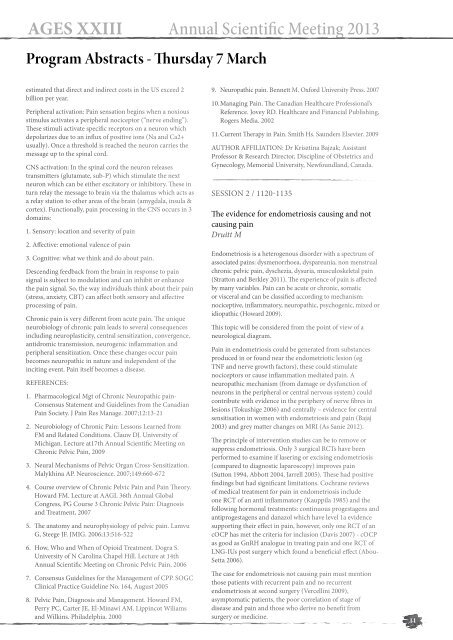AGES XXIII Annual Scientific Meeting 2013 Abstracts & Program
AGES XXIII Annual Scientific Meeting 2013 Abstracts & Program
AGES XXIII Annual Scientific Meeting 2013 Abstracts & Program
Create successful ePaper yourself
Turn your PDF publications into a flip-book with our unique Google optimized e-Paper software.
<strong>AGES</strong> <strong>XXIII</strong> <strong>Annual</strong> <strong>Scientific</strong> <strong>Meeting</strong> <strong>2013</strong><br />
<strong>Program</strong> <strong>Abstracts</strong> - Thursday 7 March<br />
estimated that direct and indirect costs in the US exceed 2<br />
billion per year.<br />
Peripheral activation: Pain sensation begins when a noxious<br />
stimulus activates a peripheral nociceptor (“nerve ending”).<br />
These stimuli activate specific receptors on a neuron which<br />
depolarizes due to an influx of positive ions (Na and Ca2+<br />
usually). Once a threshold is reached the neuron carries the<br />
message up to the spinal cord.<br />
CNS activation: In the spinal cord the neuron releases<br />
transmitters (glutamate, sub-P) which stimulate the next<br />
neuron which can be either excitatory or inhibitory. These in<br />
turn relay the message to brain via the thalamus which acts as<br />
a relay station to other areas of the brain (amygdala, insula &<br />
cortex). Functionally, pain processing in the CNS occurs in 3<br />
domains:<br />
1. Sensory: location and severity of pain<br />
2. Affective: emotional valence of pain<br />
3. Cognitive: what we think and do about pain.<br />
Descending feedback from the brain in response to pain<br />
signal is subject to modulation and can inhibit or enhance<br />
the pain signal. So, the way individuals think about their pain<br />
(stress, anxiety, CBT) can affect both sensory and affective<br />
processing of pain.<br />
Chronic pain is very different from acute pain. The unique<br />
neurobiology of chronic pain leads to several consequences<br />
including neuroplasticity, central sensitization, convergence,<br />
antidromic transmission, neurogenic inflammation and<br />
peripheral sensitization. Once these changes occur pain<br />
becomes neuropathic in nature and independent of the<br />
inciting event. Pain itself becomes a disease.<br />
REFERENCES:<br />
1. Pharmacological Mgt of Chronic Neuropathic pain-<br />
Consensus Statement and Guidelines from the Canadian<br />
Pain Society. J Pain Res Manage. 2007;12:13-21<br />
2. Neurobiology of Chronic Pain: Lessons Learned from<br />
FM and Related Conditions. Clauw DJ. University of<br />
Michigan. Lecture at17th <strong>Annual</strong> <strong>Scientific</strong> <strong>Meeting</strong> on<br />
Chronic Pelvic Pain, 2009<br />
3. Neural Mechanisms of Pelvic Organ Cross-Sensitization.<br />
Malykhina AP. Neuroscience. 2007;149:660-672<br />
4. Course overview of Chronic Pelvic Pain and Pain Theory.<br />
Howard FM. Lecture at AAGL 36th <strong>Annual</strong> Global<br />
Congress, PG Course 3 Chronic Pelvic Pain: Diagnosis<br />
and Treatment, 2007<br />
5. The anatomy and neurophysiology of pelvic pain. Lamvu<br />
G, Steege JF. JMIG. 2006;13:516-522<br />
6. How, Who and When of Opioid Treatment. Dogra S.<br />
University of N Carolina Chapel Hill. Lecture at 14th<br />
<strong>Annual</strong> <strong>Scientific</strong> <strong>Meeting</strong> on Chronic Pelvic Pain, 2006<br />
7. Consensus Guidelines for the Management of CPP. SOGC<br />
Clinical Practice Guideline No. 164, August 2005<br />
8. Pelvic Pain, Diagnosis and Management. Howard FM,<br />
Perry PC, Carter JE, El-Minawi AM. Lippincot Wiliams<br />
and Wilkins. Philadelphia. 2000<br />
9. Neuropathic pain. Bennett M. Oxford University Press. 2007<br />
10. Managing Pain. The Canadian Healthcare Professional’s<br />
Reference. Jovey RD. Healthcare and Financial Publishing,<br />
Rogers Media. 2002<br />
11. Current Therapy in Pain. Smith Hs. Saunders Elsevier. 2009<br />
AUTHOR AFFILIATION: Dr Krisztina Bajzak; Assistant<br />
Professor & Research Director, Discipline of Obstetrics and<br />
Gynecology, Memorial University, Newfoundland, Canada.<br />
SESSION 2 / 1120-1135<br />
The evidence for endometriosis causing and not<br />
causing pain<br />
Druitt M<br />
Endometriosis is a heterogenous disorder with a spectrum of<br />
associated pains: dysmenorrhoea, dyspareunia, non menstrual<br />
chronic pelvic pain, dyschezia, dysuria, musculoskeletal pain<br />
(Stratton and Berkley 2011). The experience of pain is affected<br />
by many variables. Pain can be acute or chronic, somatic<br />
or visceral and can be classified according to mechanism:<br />
nociceptive, inflammatory, neuropathic, psychogenic, mixed or<br />
idiopathic (Howard 2009).<br />
This topic will be considered from the point of view of a<br />
neurological diagram.<br />
Pain in endometriosis could be generated from substances<br />
produced in or found near the endometriotic lesion (eg<br />
TNF and nerve growth factors), these could stimulate<br />
nociceptors or cause inflammation mediated pain. A<br />
neuropathic mechanism (from damage or dysfunction of<br />
neurons in the peripheral or central nervous system) could<br />
contribute with evidence in the periphery of nerve fibres in<br />
lesions (Tokushige 2006) and centrally – evidence for central<br />
sensitisation in women with endometriosis and pain (Bajaj<br />
2003) and grey matter changes on MRI (As Sanie 2012).<br />
The principle of intervention studies can be to remove or<br />
suppress endometriosis. Only 3 surgical RCTs have been<br />
performed to examine if lasering or excising endometriosis<br />
(compared to diagnostic laparoscopy) improves pain<br />
(Sutton 1994, Abbott 2004, Jarrell 2005). These had positive<br />
findings but had significant limitations. Cochrane reviews<br />
of medical treatment for pain in endometriosis include<br />
one RCT of an anti inflammatory (Kauppila 1985) and the<br />
following hormonal treatments: continuous progestagens and<br />
antiprogestagens and danazol which have level 1a evidence<br />
supporting their effect in pain, however, only one RCT of an<br />
cOCP has met the criteria for inclusion (Davis 2007) - cOCP<br />
as good as GnRH analogue in treating pain and one RCT of<br />
LNG-IUs post surgery which found a beneficial effect (Abou-<br />
Setta 2006).<br />
The case for endometriosis not causing pain must mention<br />
those patients with recurrent pain and no recurrent<br />
endometriosis at second surgery (Vercellini 2009),<br />
asymptomatic patients, the poor correlation of stage of<br />
disease and pain and those who derive no benefit from<br />
surgery or medicine.<br />
11
















